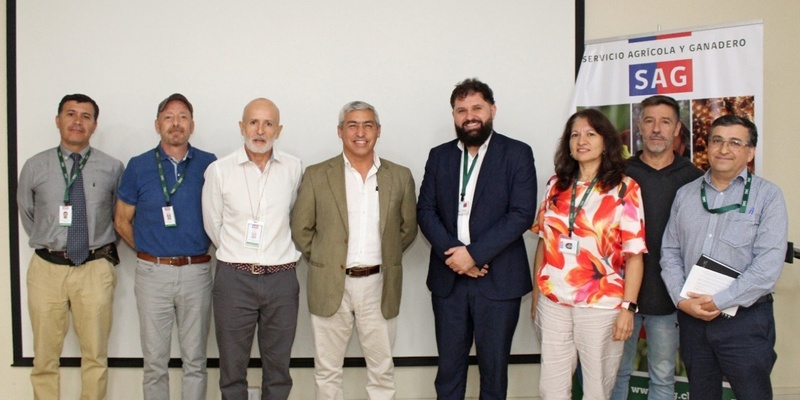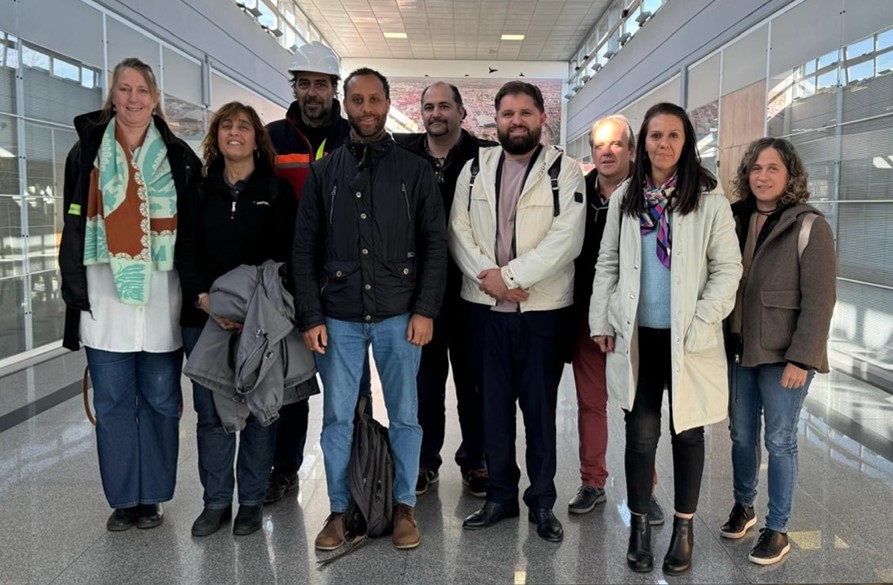Chile and Argentina: IPPC beefs up support to better manage pest risks associated with sea containers
Posted on Wed, 18 Sep 2024, 09:46

IPPC Secretariat representative (fourth from right) with members of the newly formed high-level working group to develop Chile’s sea containers management plan. © Servicio Agrícola y Ganadero (SAG)
Rome, 17 September 2024. In light of increasing pest risks associated with the movement of sea containers in international trade, the International Plant Protection (IPPC) Secretariat has been providing technical guidance to the Republic of Chile and the Argentine Republic on best practices and the latest updates from the IPPC, including developments and activities related to sea containers pest risk management.
With over 92 percent of Chile's goods imported and exported via sea containers, the Servicio Agrícola y Ganadero (SAG), Chile's national plant protection organization (NPPO), recognized the urgent need to enhance sea container pest risk management.
To address this challenge, the SAG established a high-level working group dedicated to developing a national management programme for sea containers to strengthen control measures and protect Chile's borders against the entry of pests and contaminants.
The national management programme will also emphasize the need to develop a tailored phytosanitary regulation to govern the entry of containers into Chile. Currently, the Chilean NPPO conducts inspections exclusively on sea containers transporting agricultural, forestry or livestock merchandise, thus limiting its scope. This limitation means that despite the SAG's diligent inspection of over 74 000 containers of these specified goods, it represents less than ten percent of the total containers entering Chile’s borders.
In April, the IPPC Secretariat met with SAG in Santiago de Chile to discuss activities of Chile’s newly formed high-level working group. Artur Shamilov, Agriculture Officer at the IPPC Secretariat, shared his expertise, insights and the latest developments on the work of the CPM Focus Group on Sea Containers, current best practices, as well as materials developed by the secretariat.
"In addressing the complexities of sea container management and the associated pest risks, collaboration becomes our strongest asset to mitigate risks for a more secure and resilient trade environment," Shamilov said.
“The IPPC Secretariat’s involvement laid the foundation for Chile's national programme and provided best practices, emphasizing the importance of container cleanliness in reducing pest risks,” he added.
José Guajardo Reyes, SAG National Director, emphasized the need for a comprehensive framework to intercept pests and contaminants. "Through inspection protocols and strategic partnerships, we aim to ensure the integrity of Chile’s borders and protect our important agricultural resources," Reyes stated.
Sea container inspections in Chile
The inspection process begins with the visual examination of three critical areas of the ship: the deck, the warehouse and the skips where pests are commonly harboured.
Later, containers undergo rigorous inspection for both external and internal contamination, with various factors contributing to potential infestation, including contaminated cargo, packaging, attraction of pests by ship lights, soil and plant residue and hidden pest habitats. Upon interception of pests, border authorities expeditiously send contaminated samples to the laboratory for diagnosis. This enables prompt action by applying phytosanitary measures to prevent further pest spread.
From 2018-2023, the SAG successfully intercepted 340 pests, mainly insects. Among these pests, a particular species was identified, the Khapra beetle (Trogoderma granarium), which poses significant damage to crops even in countries with a strong phytosanitary system.

Khapra beetle (Trogoderma granarium) © Organismo Internacional Regional de Sanidad Agropecuaria (OIRSA)
Khapra beetle can survive in sea containers for several years and for extended periods without food. Its population can quickly increase and can contaminate not only goods like grain but also “non-host” goods held within the container.
As Khapra beetles can remain undetected for a long time, the risk is high for contaminated containers to circulate through international trade.
The Chilean NPPO and the IPPC Secretariat agreed to continue the cooperation grounded on a shared purpose, highlighting the need for continuous collaboration to refine and effectively implement the national programme on sea containers. Advocating for continuous training and capacity-building initiatives emerged as a priority to strengthen stakeholder capabilities in navigating the complexities of sea container management to reduce pest risk associated with sea containers.
IPPC support to the Argentina NPPO (SENASA)

© SENASA
In early July, the IPPC Secretariat met with the Argentina NPPO, Servicio Nacional de Sanidad y Calidad Agroalimentaria (SENASA), to conduct training for NPPO staff on the latest IPPC updates, including developments and activities related to sea containers following the Eighteenth Session of the Commission on Phytosanitary Measures (CPM-18) in April. The training provided NPPO staff guidance on the uptake of actions to minimize pest risks associated with sea containers, as outlined in CPM Recommendation 06 and adopted at CPM-18. The training served as a critical platform for knowledge sharing, laying the foundations for policy formulation and collaboration among all relevant stakeholders.
At the training, SENASA shared how they conduct import/export phytosanitary inspection, verification of the sea container’s external and internal conditions, ship inspection to detect Lymantria spp, as well as their knowledge of the IPPC guidelines on sea container inspections.
Training participants also visited the Exolgan Container Terminal where they learned how Argentina manages sea containers, including the critical control points of sea container logistics, flow of import, export and empty containers, storage sites, warehouse verification, cleaning, disinfection and repair, and the international phytosanitary standards being implemented.
Related information:
IPPC Diagnostic Protocol 3 (available in all FAO languages)

